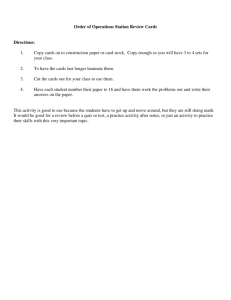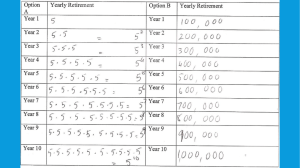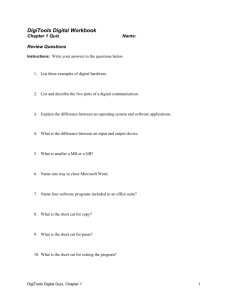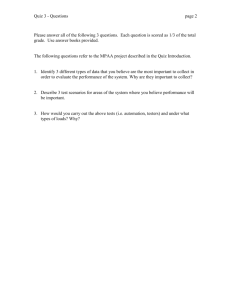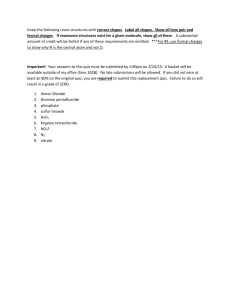2009-2010 Art I – Pacing Guide Mrs. Lightfield Resource/Text
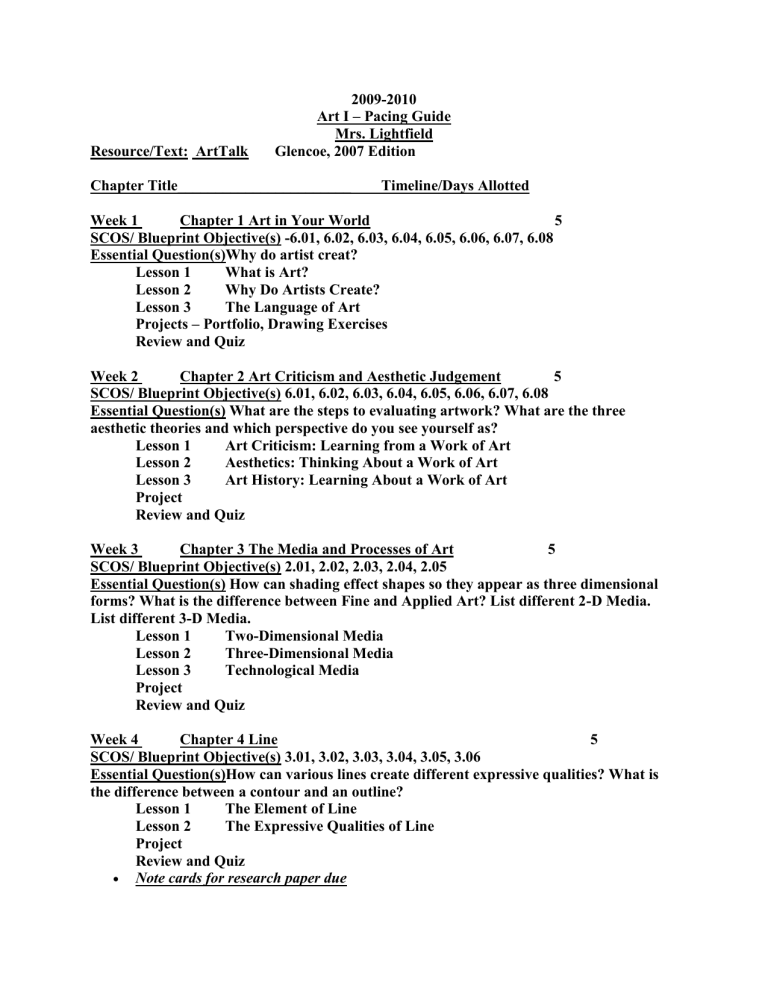
2009-2010
Art I – Pacing Guide
Mrs. Lightfield
Resource/Text: ArtTalk Glencoe, 2007 Edition
Chapter Title_______________________ Timeline/Days Allotted
Week 1 Chapter 1 Art in Your World 5
SCOS/ Blueprint Objective(s) -6.01, 6.02, 6.03, 6.04, 6.05, 6.06, 6.07, 6.08
Essential Question(s)Why do artist creat?
Lesson 1 What is Art?
Lesson 2 Why Do Artists Create?
Lesson 3 The Language of Art
Projects – Portfolio, Drawing Exercises
Review and Quiz
Week 2 Chapter 2 Art Criticism and Aesthetic Judgement 5
SCOS/ Blueprint Objective(s) 6.01, 6.02, 6.03, 6.04, 6.05, 6.06, 6.07, 6.08
Essential Question(s) What are the steps to evaluating artwork? What are the three aesthetic theories and which perspective do you see yourself as?
Lesson 1 Art Criticism: Learning from a Work of Art
Lesson 2 Aesthetics: Thinking About a Work of Art
Lesson 3 Art History: Learning About a Work of Art
Project
Review and Quiz
Week 3 Chapter 3 The Media and Processes of Art 5
SCOS/ Blueprint Objective(s) 2.01, 2.02, 2.03, 2.04, 2.05
Essential Question(s) How can shading effect shapes so they appear as three dimensional forms? What is the difference between Fine and Applied Art? List different 2-D Media.
List different 3-D Media.
Lesson 1 Two-Dimensional Media
Lesson 2 Three-Dimensional Media
Lesson 3 Technological Media
Project
Review and Quiz
Week 4 Chapter 4 Line 5
SCOS/ Blueprint Objective(s) 3.01, 3.02, 3.03, 3.04, 3.05, 3.06
Essential Question(s)How can various lines create different expressive qualities? What is the difference between a contour and an outline?
Lesson 1 The Element of Line
Lesson 2 The Expressive Qualities of Line
Project
Review and Quiz
Note cards for research paper due
Week 5 Chapter 5 Shape, Form and Space 5
SCOS/ Blueprint Objective(s) 3.01, 3.02, 3.03, 3.04, 3.05, 3.06
Essential Question(s) What is the difference between Shape and Form? Name 6 ways to create the illusion of depth or space. What can different shapes, forms and spaces express?
What is the difference between positive and negative space?
Lesson 1 Shapes and Forms
Lesson 2 Space
Lesson 3 How We Perceive Shape, Form, and Space
Project
Review and Quiz
Week 6 Chapter 5 continued 5
SCOS/ Blueprint Objective(s) 3.01, 3.02, 3.03, 3.04, 3.05, 3.06
Essential Question(s) What is the difference between Shape and Form? Name 6 ways to create the illusion of depth or space. What can different shapes, forms and spaces express?
What is the difference between positive and negative space?
Lesson 4 How Artists Create Shapes and Forms in Space
Lesson 5 What Different Shapes, Forms, and Spaces Express
Project
Review and Quiz
Rough Draft of Research Paper Due
Week 7 Chapter 6 Color 5
SCOS/ Blueprint Objective(s) 3.01, 3.02, 3.03, 3.04, 3.05, 3.06
Essential Question(s) What are hue, value and intensity as they relate to color? What are the primary, secondary, tertiary, analogous, tint, shade, warm, cool, and complementary groups each consist of?
Lesson 1 Hue, Value, and Intensity
Lesson 2 Color Schemes
Lesson 3 Understanding the Nature and Uses of Color
Review and Quiz
Week 8 Chapter 7 Texture 5
SCOS/ Blueprint Objective(s) 3.01, 3.02, 3.03, 3.04, 3.05, 3.06
Essential Question(s) What is the difference between simulated, invented and real texture?
Lesson 1 Texture in Your Life
Lesson 2 How Artists use Texture
Project
Review and Quiz
Final Research Paper Due
Week 9 5
SCOS/ Blueprint Objective(s) 3.01, 3.02, 3.03, 3.04, 3.05, 3.06
Essential Question(s) How can studying other artists’ artwork help us to become a better artist? Although artwork should ‘stand’ on its own, how can learning about the artist’s life enrich our understanding and appreciation of their artwork?
Project
Review and Quiz
Presentations of Report on Artists by Students
Week 10 Chapter 8 Rhythm and Repetition 5
SCOS/ Blueprint Objective(s) 1.01, 1.02, 1.03, 1.04, 1.05, 1.06, 1.07, 4.01, 4.02, 4.03, 4.04,
4.05
Essential Question(s) How are Visual Rhythm and musical rhythm the same? How are pattern, motifs and modules related? What are the 5 types of rhythm and pattern?
Lesson 1 Rhythm and Pattern
Lesson 2 Types of Rhythm and Pattern
Lesson 3 How Artists Use Rhythm to Create Movement
Project
Review and Quiz
Project – Copy of the Masters
Week 11 Chapter 9 Balance 5
SCOS/ Blueprint Objective(s) 1.01, 1.02, 1.03, 1.04, 1.05, 1.06, 1.07, 4.01, 4.02, 4.03, 4.04,
4.05
Essential Question(s) What is the difference between Formal and Informal Balance? What are the 5 factors that can influence the visual weight of Informal Balance?
Lesson 1 Visual Balance
Lesson 2 Informal Balance
Lesson 3 The Expressive Qualities of Balance
Project
Review and Quiz
Week 12 5
SCOS/ Blueprint Objective(s) 1.01, 1.02, 1.03, 1.04, 1.05, 1.06, 1.07, 4.01, 4.02, 4.03, 4.04,
4.05
Essential Question(s)
Project
Review and Quiz
Week 13 Chapter 10 Proportion 5
SCOS/ Blueprint Objective(s) 1.01, 1.02, 1.03, 1.04, 1.05, 1.06, 1.07, 4.01, 4.02, 4.03, 4.04,
4.05
Essential Question(s) What is the difference between Proportion and Scale? What measurement do we use to measure the human figure? How can artists use proportion and distortion for expression?
Lesson 1 The Golden Mean
Lesson 2 Scale
Lesson 3 How Artists Use Proportion and Distortion
Project
Review and Quiz
Week 14 Chapter 11 Variety, Emphasis, Harmony and Unity 5
SCOS/ Blueprint Objective(s) 1.01, 1.02, 1.03, 1.04, 1.05, 1.06, 1.07, 4.01, 4.02, 4.03, 4.04,
4.05
Essential Question(s) What is the difference between subordinate and dominant areas?
What are the 5 ways to create a focal point in artwork to accomplish emphasis? Harmony stresses similarities, variety stresses differences. Unity stresses what? What are 3 different approaches to arranging the elements to create unity?
Lesson 1 Variety, Emphasis, and Harmony
Lesson 2 Unity
Project
Review and Quiz
Week 15 Chapter 12 Art Traditions from Around the World 5
SCOS/ Blueprint Objective(s) 5.01, 5.02, 5.03, 5.04, 5.05, 5.06
Essential Question(s) What are the purposes of art during ancient times? What are the general characteristics of art of ancient cultures including Mesopotamia, Egypt, India and
China? What role did religion have in the art of India, China, Japan and the Middle East?
What are some of the purposes for which African art was created? Identify the contributions that the various pre-Columbian cultures contributed to the art world.
Lesson 1 Art of Earliest Times
Lesson 2 Art of Asia and the Middle East
Lesson 3 The Art of Africa
Lesson 4 Art of the Americas
Project
Review and Quiz
Week 16 Chapter 13 Western Traditions in Art 5
SCOS/ Blueprint Objective(s) 5.01, 5.02, 5.03, 5.04, 5.05, 5.06
Essential Question(s) Describe general characteristics of Greek, Roman, and Byzantine styles of art. Identify Romanesque and Gothic styles of art. Identify artists of the
Renaissance and describe their contributions. Describe features of Baroque and Rococo styles. Identify the main features of Neoclassical, Romantic, Impressionistic, and Post-
Impressionistic styles.
Lesson 1 The Beginnings of Western Art Traditions
Lesson 2 The Beginnings of Modern Art Traditions
Lesson 3 The Nineteenth Century
Lesson 4 Early Twentieth Century
Lesson 5 Art After 1945
Project
Review and Quiz
Week 17 Chapter 14 Careers in Art 5
SCOS/ Blueprint Objective(s) 8.01, 8.02, 8.03
Essential Question(s) Identify various careers in 2-D, 3-D art and Art Education.
Lesson 1 Careers in Two-Dimensional Art
Lesson 2 Careers in Three-Dimensional Art and Education
Project
Review and Quiz
Week 18 Review for Final Exam 5
SCOS/ Blueprint Objective(s) Review of all Objectives
Essential Question(s) Review of all Essential Questions
Complete past artwork, paperwork, projects
Review and Quiz
